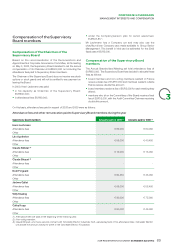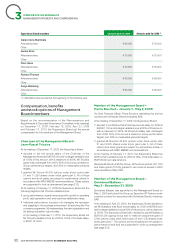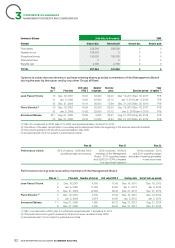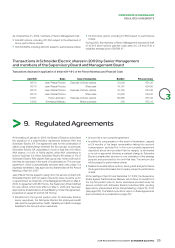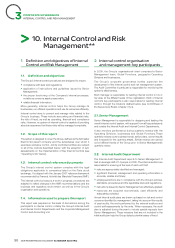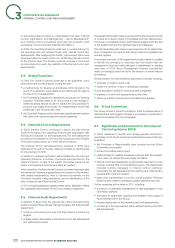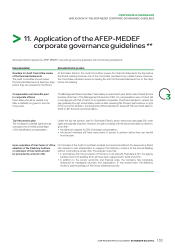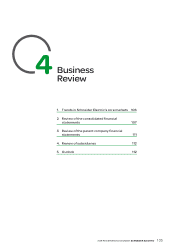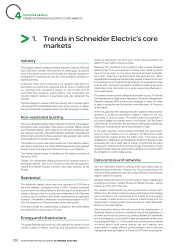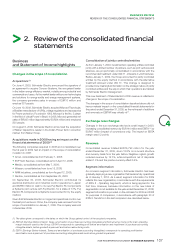APC 2009 Annual Report Download - page 99
Download and view the complete annual report
Please find page 99 of the 2009 APC annual report below. You can navigate through the pages in the report by either clicking on the pages listed below, or by using the keyword search tool below to find specific information within the annual report.
2009 REGISTRATION DOCUMENT SCHNEIDER ELECTRIC 97
CORPORATE GOVERNANCE
3
INTERNAL CONTROL AND RISK MANAGEMENT
The internal audit process is described in Section5 below.
After each internal audit, a report is issued setting out the
auditors’fi ndings and recommendations. Copies of the report are
given to the head of the audited entity, Senior Management and
the Audit Committee. The external auditors also have access to
the reports. Measures are taken to monitor implementation of
recommendations and specifi c audits are conducted if necessary.
2.3. Internal Control Department
The Internal Control Department, which was created in 2008 and
reports to the Internal Audit Department, is responsible for:
•defi ning and updating the list of Key Internal Controls in close
cooperation with the Global Functions and in line with the AMF
reference framework;
•setting up and leading a network of internal controllers in the
Operating Divisions and businesses who are responsible for
deploying the Key Internal Controls and instilling them within the
operating units in their scope—notably through training sessions
and annual self-assessments;
•analysing and critically reviewing the results of these self-
assessments to identify areas that require an action plan at the
level of the Group, an Operating Division, Business or Global
Function;
•leading the Internal Control Committee, comprising internal
controllers from the Operating Divisions and businesses, as well
as internal control correspondents from the Global Functions. The
Committee members work to improve internal control and adapt
procedures in light of the results of self-assessments and changes
in the business environment or organisation .
2.4. Finance and Control - Legal Affairs
The Finance and Control – Legal Affairs Department is actively
involved in organising control and ensuring compliance with
procedures.
Within the department, the Management Control and Accounting
unit plays a key role in the internal control system by:
•drafting and updating instructions designed to ensure that statutory
and management accounting practices are consistent throughout
the Group and in compliance with applicable regulations;
•organising period-end closing procedures;
•analysing performance and tracking the achievement of targets
assigned to the operating units.
The Management Control and Accounting unit is responsible for:
•the proper application of Group accounting principles and policies;
•the integrity of the consolidation system database;
•the quality of accounting processes and data;
•training for fi nance staff in the form of specifi c seminars;
•drafting, updating and distributing the necessary documents for
producing quality information.
The unit drafts and updates:
•a glossary of accounting terms used in the reporting package,
including a defi nition of each term;
•the chart of accounts for reporting;
•a Group statutory and management accounting standards
manual, which includes details of debit/credit pairings in the
consolidation system;
•a Group reporting procedures manual and system user’s guide;
•a manual describing the procedures to be followed to integrate
newly acquired businesses in the Group reporting process;
•an intercompany reconciliation procedure manual;
•account closing schedules and instructions.
The Management Control and Accounting unit monitors the reliability
of data from the subsidiaries and conducts monthly reviews of the
various units’primary operations and performance.
The Finance and Control – Legal Affairs Department oversees tax and
legal affairs and insurance, to provide comprehensive management
of these risks.
Treasury and fi nancing management is almost completely centralised
within the Corporate Treasury centre , which issues guidelines on
fi nancial risk management and payment security. The Corporate
Treasury centre also reviews balance sheet changes and fi nancial
risks at the Group’s companies on an annual basis during formal
fi nancial review meetings.Procedures for managing fi nancial risk are
described in “Risk Factors”.
2.5. Operating Divisions and businesses
Operating units
The Operating Division and Business management teams play a
critical role in effective internal control.
All Group units report to one of the Operating Divisions or businesses,
which are managed by an Executive Vice President, supported by
a fi nancial controller.
The Executive Vice Presidents of the Operating Divisions and
businesses sit on the Executive Committee chaired by the Chairman
of the Management Board. The fi nancial controllers report to the
corporate Management Control unit.
Within each division, the management team organises control of
operations, ensures that appropriate strategies are deployed to
achieve objectives and tracks unit performance.
A Management Committee led by the corporate Management
Control and Accounting unit reviews the transactions of the Divisions
and businesses on a monthly basis.
The Operating Divisions and businesses have teams of internal
controllers who organise training on Key Internal Controls for the
units in their scope and analyse the quality of the internal control
self-assessments—including ratings and action plans—sent back
by the units. They detect internal control issues that require action
plans in some or all of the units under their responsibility. They also
identify units that need specifi c assistance and either implement or
oversee the implementation of the appropriate support. Lastly, the
internal control teams offer suggestions for enhancing and updating
the Key Internal Controls.
2.6. Global Functions
(Human Resources, Purchasing,
Manufacturing, Supply Chain,
InformationSystems, etc.)
Schneider Electric centralises decision making and risk management
at the corporate level through specifi c bodies such as the Group
Acquisitions Committee (see “Risk Factors”), by combining certain
functions within the Finance and Control – Legal Affairs Department
(see above) and through dedicated Global Functions.




